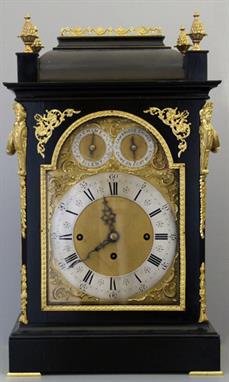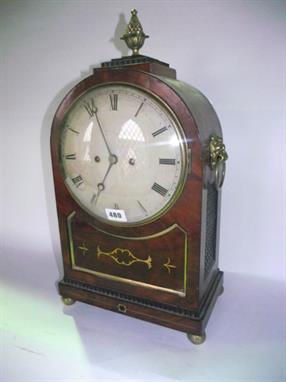Richard White, North Walsham, a George III oak eight day longcase clock, the 11" break arch brass dial with silvered chapter, subsidiary seconds and date aperture, signed in the arch, the arched hood carved with a blind fretwork band above Corinthian columns, the case with fluted canted corners flanking a door with a glazed lenticle, the panel base raised on bracket feet. 223cm
We found 28112 price guide item(s) matching your search
There are 28112 lots that match your search criteria. Subscribe now to get instant access to the full price guide service.
Click here to subscribe- List
- Grid
-
28112 item(s)/page
Joseph Heppell Maughan, Gateshead (1834-64), an oak eight day longcase clock, the 13" painted break arch dial with subsidiary seconds and date dial, painted in the arch with a milkmaid and a shell to each corner, the arch top hood with turned columns, the case with pointed arch door flanked by quarter columns, raised on bracket feet. 217cm
C18th/C19th Mahogany Long Case Clock on small bracket supports with box wood & ebony stringing, domed trunk door, domed hood with fluted pillars encasing brass dial, brass chapter ring with Roman numerals, painted metal pierced hands, dome mounted with scrolling fish & Tempus Fugit, musical Westminster chiming German replacement, 1930`s movement, striking on bars, with triple weights, full size pendulum
A mahogany longcase clock, the 33cm (13") arch brass dial with broken arch pediment and fluted pilaster above a cross banded door and base on ogee bracket feet, the dial signed Lowry, White Haven, 233.75cm (92") high/see illustration Condition Report: The clock is original and at present in working order, country house condition with lots of mildew inside case. Seems strange that the pillars are proud of the cornice but the cornice has been there a long time, the broken arch seems to finish abruptly leaving a disproportionate gap; maybe it once had an earlier lantern or bell top, long removed.
Georgian style ebonised and gilt eight-bell bracket clock , late 19th century, the bell top case with pineapple finials, grille sides and applied ornament, the break arch dial with silvered chapter ring, chime/silent and Cambridge/eight-bells, the unsigned eight day triple movement with an engraved backplate and pendulum, chiming the quarter on bells and striking the hour on a coil, height 54cm (winds, strikes, chimes, ticks; pendulum, winding and door keys). *See clocks and watches proviso. Condition report: see terms and conditions.
George III mahogany longcased clock by Thomas Cawson, Liverpool, white painted break arch Roman dial with maritime rolling moon and floral spandrels, eight day striking movement, in a swan neck hood with eagle finials, gilded panels, plain columns, over a triple arch door flanked by full columns, on a cut corner base and ogee bracket feet, height 253cm (two weights, pendulum). *See clocks and watches proviso. Condition report: see terms and conditions.
A good 18th century mahogany eight day long case clock, the brass dial signed J.N.O. Pitts, Tilbury, beneath an ornate, cherub, arch, the case with blind fret, canted corners beneath a fret pierced and flowerhead carved pediment, the whole on ogee bracket feet, maximum height 244cm. Condition Report: We do not operate the clocks to see if in working order and do not guarantee the workings. There are three holes drilled into the brass dial where the movement posts are connected therefore uncertain if the movement is original. The seating boards are built up. The edge of the trunk door has some damage together with the back legs missing.
A 19th century miniature mahogany grandfather clock with square hood and broken scroll pediment. There is a hinged glass door to the silvered dial bearing a primitive Roman five minute interval chapter ring. The obelisk shaped trunk has a hinged door and is surmounted on a mahogany wall bracket. The clock movement bears the maker`s name Ansonia Clock Company. Patented May 3rd 1892. Length 43 cm
Late seventeenth century spring-driven bracket clock with eight day, six pillar single fusee timepiece movement with latched plates, turned tulip pillars and anchor escapement, engraved back plate with tulip and foliate decoration, signed - Howard Londini Fecit, six and a half inch square brass dial with winged cherub spandrels, silvered chapter ring with Roman numerals and feather hour divisions, signed - Howard London, matted centre with mock pendulum aperture and cut glass false pendulum bob, pierced hands. In an ebonised fruitwood case with basket top and gilt repoussé mounts with pierced floral decoration and decorative swing handle, square front door with top glass panel with cut floral insert, engraved keyhole escutcheon and false keyhole escutcheon, glass side panels and rear door with glass panel and cockbeaded border, on four bracket feet, circa 1695, 36cm overall height x 23.5cm overall width. N.B. John Howard, clockmaker, was working in London in the 1690s CONDITION REPORT Movement is clean and as far as we know in working order. Originally verge now converted to anchor. There are several vacant holes in back plate. Movement sits quite low in the case and the whole movement is very narrow. Dial is in good condition but dirty. Case is quite good but has been repaired and restored. Insert behind glass panel above dial is damaged. Key hole escutcheons may be replacements. Base has been lowered to accommodate pendulum. Case also appears to have been made originally to accommodate bell or bells
A good early 19th c. Mahogany Longcase Clock with brass mounted swan pediment top, turned supports and single pane glazed door. Painted face with date roller and thirty hour movement. Signed B. Greening of Chepstow, short door case with canted corners, lower moulding and standing on bracket feet. 19'' wide x 83'' high x 9 3/4'' deep.
A. Breckenridge of Kilmarnock, an early 19th century mahogany, strung and inlaid longcase clock with painted face supporting a twin train striking movement under an arched rectangular hood, the trunk with a rectangular door on a plain base CONDITION REPORT: Face with crackleure and some losses, case with wear commensurate with age, bracket feet missing no guarantee as to working order
A George III 8 day walnut long case clock by Thomas Hall, Cannongate, the broken pediment with ball and eagle finial, brass finials, applied chapter ring, mask spandrels, Roman numerals, subsidiary second dial, date aperture, anchor escapement, striking bell, flanked by Doric column, arched trunk door, on plinth base with bracket feet, 245cm high
A 20th Century mahogany diminutive longcase clock with eight day movement and Westminster chime on gongs, the brass break arch dial with silvered chapter ring and Roman numerals beneath a silvered boss inscribed `Canham London`, the hood with moulded arch pediment and glazed door, the case with moulded trunk door on a plain base and bracket feet, height approx 149cm, together with pendulum.
A 20th Century oak diminutive longcase clock with eight day movement chiming on gongs, the brass break arch dial inscribed `Tempus Fugit`, the hood with arched pediment and glazed door, the trunk door with glazed lenticle on a plain base and bracket feet, height approx 165.5cm, together with a pendulum.
A late 19th Century brass four glass table clock with perpetual calendar and moonphase, the eight day movement striking on a bell, the backplate stamped `V.R. Breveté Paris` and `J. Marti CIE`, supporting a compensated mercury pendulum, the two piece white enamel dial with Roman numerals and visible Brocot escapement, above a further enamel dial annotated with months of the year to circumference, enclosing subsidiary day, date and moonphase, both set within a gilt brass surround, the bevel glazed case with moulded top and base, on bracket feet, height approx 33.5cm.
A French Empire ormolu mantel clock with eight day movement striking on a bell via an outside countwheel, the circular dial with black Roman numerals and inscribed `Galle Rue De Richelieu`, the arched case of niche form cast in relief with a scantily clad classical couple embracing, within an anthemion and scroll border, on a rectangular base and bracket feet, height approx 48.5cm, with a key (lacking pendulum).
A George III and later ash longcase clock with eight day movement striking on a bell, the square brass dial with engraved foliate centre, subsidiary seconds and date aperture framed by a chapter ring with Roman numerals and inscribed `Edward Upjohn, Exon`, the hood with glazed door and brass ball finials above an arched trunk door, plain base and bracket feet, height approx 205cm, together with two weights (faults, alterations and lacking pendulum).
A Regency figured mahogany bracket clock with eight day twin fusee movement striking on a bell, the painted circular dial with Roman numerals, strike/silent indicator and inscribed `Yonge & Son, Strand, London`, the back plate with engraved foliate border, the case with stepped surmount above a pair of gilt brass fruit basket and loose ring handles and pierced scale fret panels, the front with brass edged recessed corner panels, on a rectangular base and brass ball feet, height approx 36cm, together with pendulum, winder and case key.
A Regency mahogany and brass bracket clock, the eight day triple fusee movement with verge escapement striking hours on a large bell and chiming quarters on ten bells with pull repeat, the painted break arch dial with subsidiary chime/silent indicator to arch above Roman numerals and inscribed `Barrauds, Cornhill, London`, the engraved back plate similarly inscribed, the pagoda top case with ball finials and scale fretted frieze above a pair of similarly fretted side panels and foliate cast carrying handles flanked by a pair of stop-fluted columns, the rectangular base with boxwood line inlaid decoration above a brass bound apron and cast paw feet, height approx 70cm, together with case key and later winding key (minor faults).
A late 19th Century French walnut and ebonized mantel clock with eight day movement striking on a bell, the enamel dial with Roman numerals, the architectural case with turned finial surmounts, height approx 37cm, with pendulum, together with a George V oak cased mantel clock with eight day movement striking on a gong, the silvered dial with Arabic numerals, the arched case with barley twist corner columns on bracket feet, together with two pendulums and winding keys.
-
28112 item(s)/page



























































